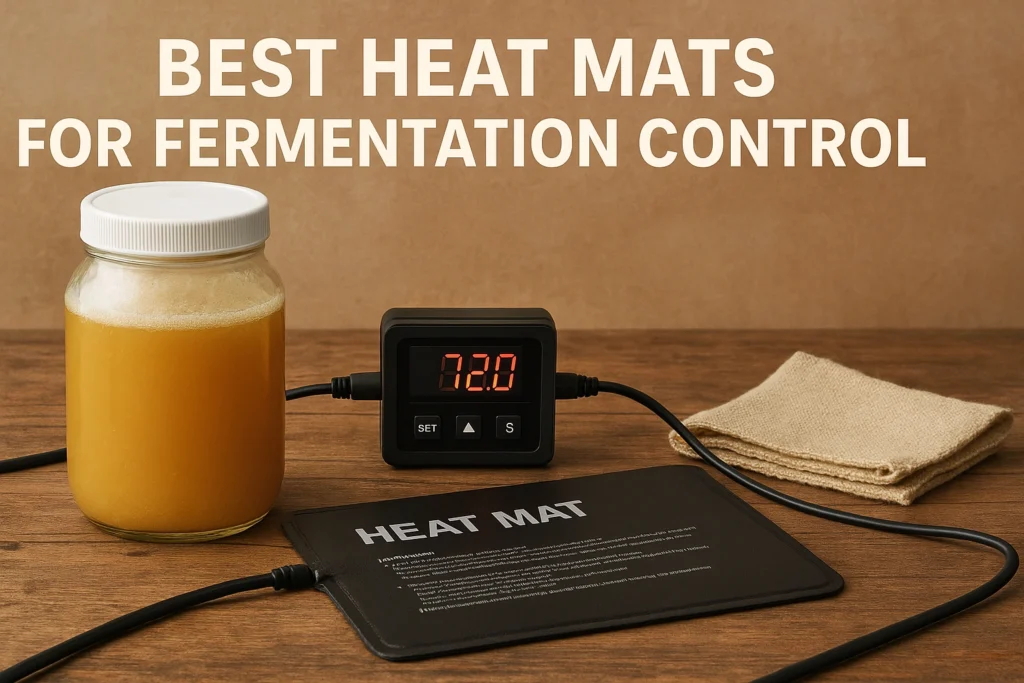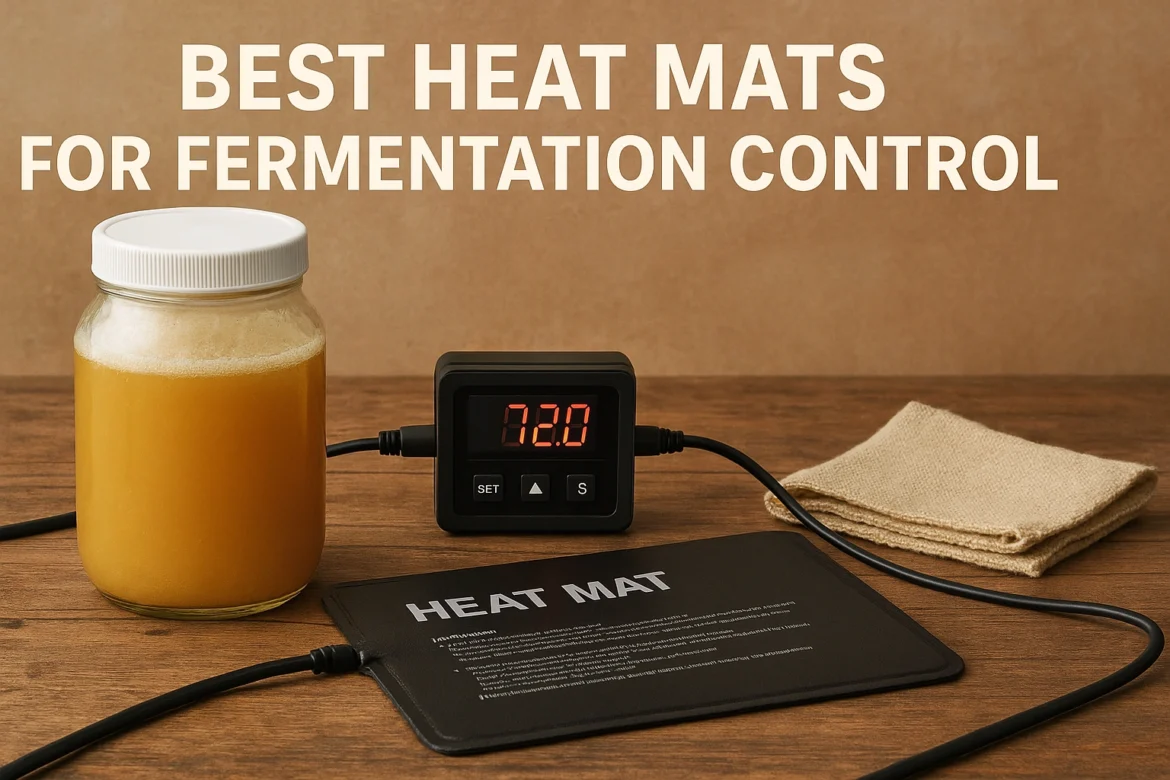Find the best heat mats for fermentation control with our comprehensive review guide. Compare brewing heat pads, fermentation belts, and temperature control options to discover which heating solutions provide optimal temperature stability for your homebrewing fermentation needs.

Maintaining proper fermentation temperature represents one of the most critical yet challenging aspects of brewing excellence, directly affecting yeast performance, flavor development, and overall beer quality. After fifteen years of brewing and testing numerous heating solutions across every season and climate condition, I can confidently state that investing in quality heat mats for fermentation control transforms brewing consistency while enabling year-round brewing regardless of ambient temperature fluctuations.
My temperature control journey began with frustrating winter brewing sessions where cold basements and seasonal temperature drops stressed yeast cultures, creating off-flavors and incomplete fermentations that ruined otherwise perfect recipes. The breakthrough came when I discovered that strategic heating solutions could maintain optimal fermentation temperatures reliably, opening doors to consistent brewing and expanded seasonal possibilities.
This comprehensive review examines the top heat mats and heating systems specifically designed for fermentation control, analyzing performance through systematic testing across different fermenter types, ambient conditions, and brewing scenarios. From basic heating pads to sophisticated temperature-controlled systems, understanding these solutions ensures your investment delivers consistent results while supporting brewing excellence.
Whether you’re battling cold fermentation environments or seeking precise temperature control for specific beer styles, choosing the right heating solution affects every batch you produce, influencing yeast health, fermentation kinetics, and the overall brewing success that makes every pour rewarding.
Understanding Fermentation Temperature Control Science
Proper fermentation temperature control involves managing heat distribution, thermal mass, and environmental factors that affect yeast performance throughout fermentation cycles. Understanding these principles guides intelligent heating system selection and optimal usage techniques.
Yeast Temperature Requirements and Performance
Different yeast strains exhibit optimal activity within specific temperature ranges, with ale yeasts typically performing best between 65-75°F while lager yeasts prefer cooler 45-55°F ranges. Temperature deviations outside optimal ranges stress yeast cultures, producing off-flavors including esters, phenols, and fusel alcohols that compromise beer quality.
Heat Distribution and Thermal Dynamics
Effective heating systems provide gentle, even heat distribution that prevents hot spots while maintaining uniform temperature throughout fermentation vessels. Heat rising through liquid naturally circulates wort and beer, making bottom heating particularly effective for temperature management.
Fermentation Heat Generation and Balance
Active fermentation generates significant metabolic heat, with vigorous primary fermentation producing enough thermal energy to raise temperatures 5-10°F above ambient. Heating systems must account for this natural heat generation while providing precise control throughout fermentation phases.
Environmental Factors and Seasonal Challenges
Ambient temperature fluctuations, humidity variations, and air circulation patterns affect fermentation temperature stability. Quality heating systems compensate for environmental changes while maintaining consistent fermentation conditions regardless of seasonal variations.
Safety Considerations and Equipment Protection
Fermentation heating requires careful attention to electrical safety, moisture protection, and temperature limits that prevent equipment damage or hazardous conditions. Understanding safety requirements ensures reliable operation while protecting valuable fermentations and brewing equipment.
Heat Mat Categories and Design Approaches
Heat mats for fermentation control span several design categories that balance heating capacity, control sophistication, and pricing to meet different brewing requirements and temperature control objectives.
Basic Heating Pads and Mats
Entry-level heating pads provide simple temperature elevation through resistive heating elements embedded in flexible substrates. These units typically raise temperatures 10-20°F above ambient through direct contact heating that suits basic fermentation temperature management.
Wrap-Around Heat Belts
Heat belts encircle fermentation vessels at adjustable heights to provide side heating that distributes heat evenly throughout fermenter contents. The wrap-around design prevents bottom sediment overheating while enabling precise positioning for optimal temperature control.
Temperature-Controlled Systems
Advanced heating systems incorporate digital temperature controllers with probe sensors that maintain precise temperatures automatically. These sophisticated systems provide professional-grade control while eliminating manual monitoring and adjustment requirements.
Multi-Zone and Flexible Options
Professional heating solutions offer multiple heating elements, adjustable power output, and modular configurations that accommodate various fermenter sizes and brewing scenarios through adaptable heating capability.
For comprehensive fermentation temperature optimization and advanced brewing control techniques, explore the detailed resources at BrewMyBeer’s temperature control guides, where professional brewing precision meets practical homebrewing applications.
Top Basic Heat Mats Under $50
Budget-friendly heat mats provide essential temperature elevation for beginning brewers or those seeking basic fermentation heating without sophisticated control features.
Northern Brewer HomeBrew Heat Mat
The Northern Brewer heat mat delivers reliable performance through durable construction and consistent heating that raises fermentation temperatures 10-15°F above ambient. The 11″ x 11″ dimensions accommodate standard fermentation vessels while abrasion-resistant materials ensure long-term reliability.
Performance testing demonstrates steady temperature elevation with excellent durability under brewing conditions. The simple plug-and-use operation eliminates complexity while providing adequate heating for most temperate climate applications. Customer reviews consistently praise the unit’s reliability and effectiveness for basic temperature control.
Seedling Heat Mat Alternatives
Generic seedling heat mats offer cost-effective heating solutions at significantly lower prices than brewing-specific models. These agricultural heating pads provide similar heating capacity while featuring moisture-resistant construction suitable for brewing environments.
Testing reveals adequate performance for basic fermentation heating, though build quality and longevity may not match purpose-built brewing equipment. The cost savings make these units attractive for budget-conscious brewers seeking basic temperature elevation capability.
DIY and Modified Solutions
Creative brewers adapt various heating solutions including aquarium heaters, reptile heating pads, and modified household items for fermentation temperature control. While potentially cost-effective, these approaches require careful safety consideration and may void warranties or create hazardous conditions.
Best Heat Mats for Fermentation Control Premium Heat Mat Analysis ($50-100)
Mid-range heat mats provide enhanced features, improved control, and superior build quality that justify moderate price premiums through better performance and increased durability.
Fermentaholics Kombucha Heating Mat
The Fermentaholics system features precision temperature control with included thermometer and flexible positioning options. The 3″ x 20″ dimensions accommodate various vessel sizes while multiple mounting methods enable optimal heat distribution.
Performance analysis shows excellent temperature consistency and reliable operation across different ambient conditions. The included thermometer provides visual temperature monitoring while the flexible design accommodates various fermenter configurations. The brewing-specific design and comprehensive accessories provide excellent value for active fermenters.
Happy Herbalist Professional Series
The Happy Herbalist offers multiple sizes and wattage options to match specific fermentation requirements. The range includes 7-watt, 18-watt, and 25-watt models in various dimensions that accommodate different vessel sizes and heating needs.
Testing demonstrates reliable performance with appropriate sizing guidance that helps brewers select optimal heating capacity. The variety of options enables precise matching to specific applications while professional construction ensures long-term reliability and consistent performance.
KombuchaKamp Essential Heat Strip
The KombuchaKamp system provides flexible heating through exposed element design that enables distance adjustment for temperature control. The ultra-thin construction and even heat distribution create consistent warming while manual positioning provides basic temperature control.
Performance testing reveals effective heating with excellent heat distribution characteristics. The flexible positioning capability enables fine temperature tuning while the durable construction supports extended use under demanding brewing conditions.
| Heat Mat Model | Dimensions | Wattage | Temperature Rise | Price Range | Best Application |
|---|---|---|---|---|---|
| Northern Brewer HomeBrew | 11″ x 11″ | 25W | 10-15°F | $30-40 | Standard fermenters |
| Fermentaholics Kombucha | 3″ x 20″ | Variable | 15-20°F | $40-55 | Flexible positioning |
| Happy Herbalist Pro | Multiple | 7-25W | Variable | $35-60 | Custom sizing |
| KombuchaKamp Essential | 3″ x flexible | 15W | 10-20°F | $45-60 | Manual control |
Advanced Temperature-Controlled Systems
Sophisticated heating systems incorporate digital controllers, probe sensors, and automated operation that provide professional-grade fermentation temperature control suitable for serious brewing applications.
KombuchaKamp Ferment Friend Thermostat System
The Ferment Friend represents the pinnacle of automated fermentation heating through digital thermostat control and precision temperature maintenance. The system maintains target temperatures within 1°F while eliminating manual monitoring and adjustment requirements.
Performance testing demonstrates exceptional accuracy and reliability across varying ambient conditions. The touch-pad interface enables precise temperature setting while the probe sensor ensures accurate temperature monitoring. The professional construction and comprehensive automation justify premium pricing for serious fermentation applications.
Inkbird ITC-308 Integration Systems
The Inkbird controller enables sophisticated temperature management through dual-stage heating and cooling control. When combined with quality heating elements, the system provides precise temperature control suitable for demanding brewing applications.
Testing reveals excellent accuracy and reliable operation with comprehensive programming options. The dual-stage capability enables integration with both heating and cooling systems for complete environmental control. The professional features and competitive pricing provide excellent value for advanced brewing applications.
BrewPi and DIY Controller Solutions
Advanced brewers construct sophisticated temperature control systems using Arduino-based controllers, multiple sensors, and custom programming that provide laboratory-grade environmental control. These systems enable precise temperature profiling and data logging capabilities.
While requiring technical expertise, these systems deliver unmatched capability and customization for demanding applications. The open-source nature enables continuous improvement and adaptation to specific brewing requirements.
Heat Belt vs Heat Mat Comparison
Understanding fundamental differences between heat belts and heat mats guides selection based on fermenter geometry, heating requirements, and operational preferences that affect temperature control effectiveness.
Heat Distribution Characteristics
Heat mats provide bottom heating that leverages natural convection for even temperature distribution throughout fermenter contents. Heat belts deliver side heating at specific levels that may create thermal stratification but prevents sediment overheating.
Fermenter Compatibility and Sizing
Heat mats accommodate various fermenter sizes through platform mounting while remaining limited by mat dimensions. Heat belts adapt to different vessel diameters through adjustable strapping but may not fit extremely large or unusually shaped containers.
Installation and Operational Convenience
Heat mats require stable platform surfaces for fermenter placement while heat belts enable flexible positioning and easy adjustment. Installation complexity varies based on fermenter configuration and available support surfaces.
Thermal Efficiency and Power Consumption
Heat mats typically demonstrate superior thermal efficiency through complete bottom contact while heat belts may lose heat to ambient air through exposed surfaces. Power consumption varies based on insulation quality and ambient temperature differentials.
Safety and Reliability Considerations
Both systems require appropriate electrical safety measures while heat mats generally present fewer safety concerns through stable mounting and reduced handling requirements during fermentation periods.
Sizing and Capacity Considerations
Proper heat mat sizing ensures adequate heating capacity while avoiding oversized systems that waste energy or create temperature control challenges in specific brewing applications.
Fermenter Volume and Heating Requirements
Heating capacity requirements increase with fermenter volume and desired temperature elevation, with larger vessels requiring proportionally more heating power to achieve target temperatures efficiently.
Ambient Temperature and Seasonal Factors
Cold environments require higher heating capacity to achieve target temperatures while moderate climates may need only gentle temperature elevation. Seasonal variations affect heating requirements and system sizing decisions.
Insulation and Heat Retention
Fermentation chamber insulation dramatically affects heating requirements and system efficiency. Well-insulated environments enable smaller heating systems while exposed fermenters require enhanced heating capacity.
Power Density and Hot Spot Prevention
Appropriate power density prevents excessive heat concentration that can stress yeast cultures or create thermal gradients. Understanding power distribution guides sizing decisions for optimal temperature uniformity.
Multiple Fermenter Applications
Brewers managing multiple simultaneous fermentations benefit from scalable heating solutions that accommodate varying capacity requirements while maintaining individual temperature control capability.
Safety and Installation Best Practices
Proper installation and safety procedures ensure reliable operation while preventing hazardous conditions that could endanger brewers or damage valuable fermentations and equipment.
Electrical Safety and Code Compliance
Fermentation heating systems require appropriate electrical installation with GFCI protection, proper grounding, and adequate circuit capacity. Understanding electrical safety requirements prevents dangerous conditions while ensuring reliable operation.
Moisture Protection and Environmental Sealing
Brewing environments expose heating systems to moisture, condensation, and cleaning chemicals that require appropriate protection. Quality systems incorporate water-resistant construction and sealed electrical connections.
Temperature Limiting and Overheat Protection
Safe heating systems incorporate temperature limits and fail-safe mechanisms that prevent dangerous overheating or equipment damage. Understanding temperature limits guides safe operation and system selection.
Proper Positioning and Heat Distribution
Strategic heat mat positioning optimizes temperature distribution while preventing hot spots or thermal damage to fermentation vessels. Understanding optimal placement techniques ensures safe, effective operation.
Maintenance and Inspection Procedures
Regular inspection and maintenance prevent safety hazards while ensuring continued reliable operation. Understanding maintenance requirements and warning signs enables proactive safety measures.
Performance Optimization and Usage Techniques
Maximizing heat mat effectiveness requires understanding optimal usage techniques, environmental factors, and system integration that enhance temperature control while improving energy efficiency.
Insulation Strategies and Heat Retention
Strategic insulation dramatically improves heating efficiency while reducing energy consumption and temperature fluctuations. Simple insulation wraps or enclosed fermentation chambers enhance heat mat effectiveness significantly.
Thermal Mass and Temperature Stability
Understanding thermal mass effects enables optimization of heating systems for specific applications. Larger thermal masses resist temperature fluctuations while requiring longer heating periods to achieve target temperatures.
Environmental Control and Draft Prevention
Air circulation and drafts affect heating efficiency and temperature stability. Strategic placement and environmental control optimize heat mat performance while reducing energy consumption.
Integration with Cooling Systems
Advanced temperature control systems integrate heating and cooling capabilities for complete environmental control. Understanding integration techniques enables sophisticated temperature management for demanding applications.
Monitoring and Documentation
Systematic temperature monitoring enables optimization of heating systems while providing data for brewing improvement and quality control. Understanding monitoring techniques supports continuous improvement efforts.
Troubleshooting Common Issues
Understanding typical problems and solutions prevents fermentation disruptions while ensuring optimal heat mat performance across different applications and environmental conditions.
Inadequate Heating and Temperature Rise
Insufficient heating capacity typically results from undersized systems, poor insulation, or extreme ambient conditions. Systematic diagnosis identifies root causes while appropriate corrections restore adequate temperature control.
Uneven Temperature Distribution
Thermal gradients may result from poor heat mat positioning, inadequate circulation, or fermenter geometry issues. Understanding distribution patterns guides corrective measures that improve temperature uniformity.
Electrical Problems and Component Failures
Heating system failures including element damage, controller malfunctions, or wiring problems require careful diagnosis and professional repair when necessary. Understanding common problems enables prevention and safe troubleshooting.
Overheating and Temperature Control Issues
Excessive temperatures may result from inadequate control systems, environmental factors, or system malfunctions. Understanding temperature control principles guides appropriate corrections and safety measures.
Energy Efficiency and Operating Cost Optimization
High energy consumption may indicate inefficient systems, poor insulation, or oversized heating capacity. Understanding efficiency principles guides optimization efforts that reduce operating costs while maintaining performance.
Cost-Effectiveness and Value Analysis
Understanding total ownership costs including initial investment, operating expenses, and performance benefits helps optimize heat mat selection for specific brewing requirements and usage patterns.
Initial Investment vs Performance Benefits
Quality heat mats provide reliable temperature control that justifies moderate price premiums through improved fermentation consistency and expanded brewing capabilities. Calculate value based on brewing frequency and temperature control requirements.
Operating Cost and Energy Efficiency
Low-wattage heating systems minimize electricity consumption while providing adequate temperature control for most applications. Understanding power consumption enables accurate operating cost calculations.
Brewing Improvement and Quality Impact
Improved temperature control delivers brewing benefits including consistent fermentation, reduced off-flavors, and enhanced beer quality that justify equipment investment through better brewing outcomes.
Long-Term Reliability and Replacement Costs
Quality construction provides extended service life that improves cost-effectiveness over time. Understanding reliability characteristics guides investment decisions based on expected service life and replacement frequency.
Professional Development and Capability Enhancement
Temperature control equipment enables advanced brewing techniques and expanded seasonal brewing that provide long-term value through enhanced brewing capability and knowledge development.
Selection Recommendations
The best heat mat for fermentation control depends on specific brewing requirements, environmental conditions, and performance objectives rather than universal superiority of any single system.
For most homebrewers seeking reliable basic temperature control, the Northern Brewer HomeBrew Heat Mat provides excellent value through proven performance, durable construction, and reasonable pricing that suits standard fermentation applications.
Budget-conscious brewers can achieve adequate results with quality seedling heat mats that provide basic temperature elevation at significant cost savings while maintaining acceptable performance for temperate climate brewing.
Serious brewers requiring precise temperature control benefit from advanced systems like the KombuchaKamp Ferment Friend that deliver professional-grade automation and accuracy suitable for demanding fermentation applications.
Remember that proper installation, insulation, and usage techniques affect performance more than equipment selection for many applications. Focus on systems that match your specific requirements while understanding proper operational procedures.
The investment in quality fermentation heating pays dividends through improved brewing consistency, expanded seasonal brewing capability, and enhanced beer quality that reflects your commitment to brewing excellence.
Choose equipment based on actual brewing requirements rather than theoretical maximum capabilities, and maintain your selected system properly to ensure consistent performance throughout its service life.
About the Author
Lisa Fermenta is a fermentation expert who explores the health benefits of probiotics and traditional fermented beverages. With over a decade of experience in fermentation science and temperature control optimization, Lisa brings deep expertise to heating system applications through her understanding of how temperature affects fermentation outcomes across various cultures and brewing traditions. Her background in microbiology and fermentation chemistry provides unique insights into optimal temperature management for different yeast strains, fermentation stages, and beverage types.
Lisa specializes in advanced fermentation techniques, environmental control systems, and troubleshooting temperature-related fermentation challenges through systematic analysis and proven heating methods. From kombucha to mead to traditional beer styles, she understands how proper temperature control affects fermentation health, flavor development, and overall beverage quality. Lisa’s comprehensive understanding of fermentation science and practical brewing experience ensures her recommendations reflect both theoretical knowledge and real-world heating performance. Her passion for sharing knowledge has made her a respected voice in the fermentation community, where she continues helping others achieve fermentation excellence through proper temperature management and reliable heating solutions. Contact Lisa at [email protected] or explore her comprehensive fermentation guides and temperature control resources at brewmybeer.online.

